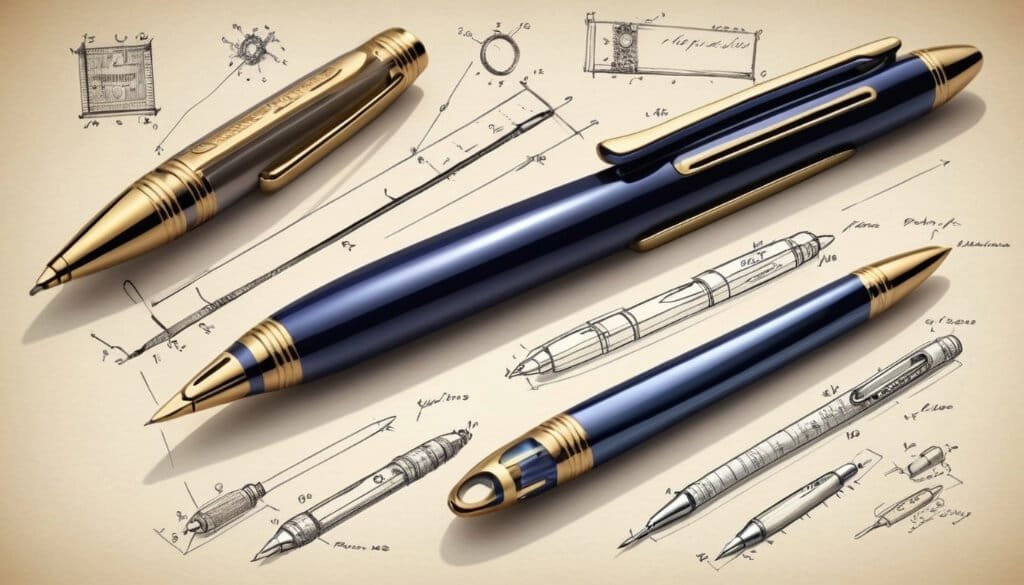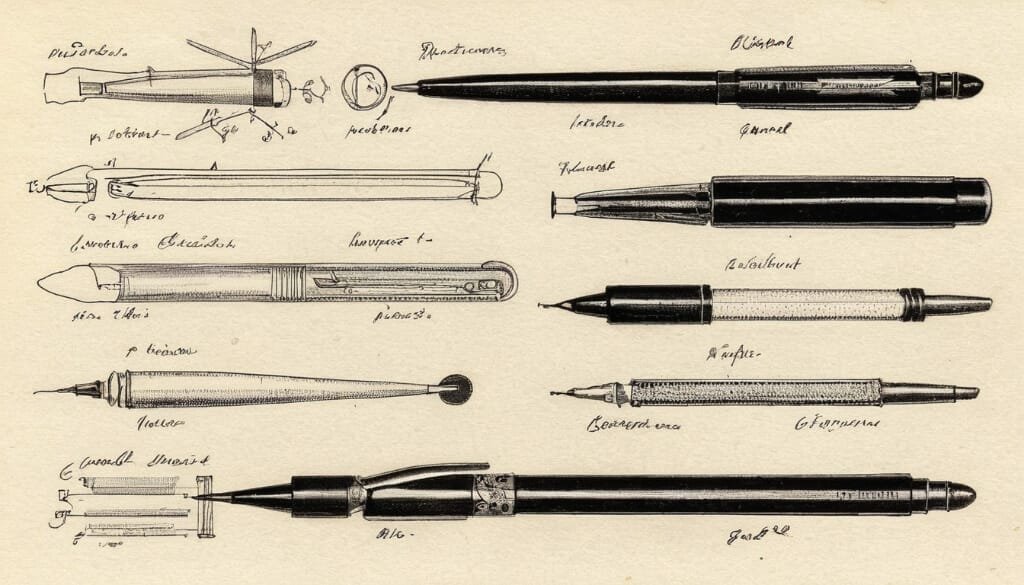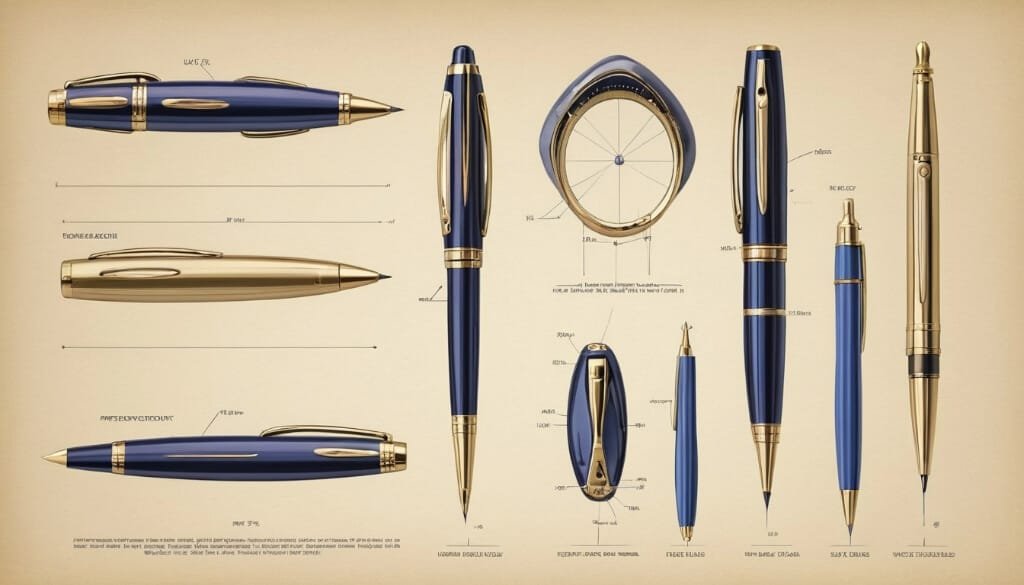Pens have been indispensable tools for human communication and creativity throughout history. From ancient civilizations to the modern era, pens have evolved significantly, yet many groundbreaking inventions have been forgotten or overlooked. In this article, we embark on a journey to rediscover forgotten pen inventions that have shaped the way we write and communicate.

Ancient Innovations: Pens Of Antiquity
In human history, the quest for written expression has spurred remarkable ingenuity, leading to the creation of various writing instruments across ancient civilizations. The pens of antiquity, though often overshadowed by modern counterparts, reveal a fascinating tapestry of innovation and craftsmanship.
Ancient civilizations such as Mesopotamia, Egypt, and China each developed their unique writing instruments. Mesopotamian scribes wielded styluses made of reeds or metal, impressing wedge-shaped characters into clay tablets. These early pens, although rudimentary by modern standards, laid the groundwork for written communication.
Egyptian civilization, famed for its hieroglyphics, employed reed pens known as “calamus” to inscribe intricate symbols on papyrus scrolls. These pens, crafted from the stems of the papyrus plant, enabled scribes to record religious texts, administrative records, and literary works with remarkable precision.
Meanwhile, in ancient China, scholars utilized brushes crafted from animal hair, such as wolf, rabbit, or goat, to write characters on silk or bamboo strips. These brushes, known as “bi” or “maobi,” were prized for their versatility and fluidity, allowing for expressive calligraphy that remains revered to this day.
The materials and mechanisms used in these ancient pens varied greatly, reflecting the cultural, environmental, and technological landscapes of their respective civilizations. While some pens were disposable and easily replaceable, others were crafted with meticulous care and designed to last for generations.
Despite their significance in shaping the course of human history, many of these ancient pen inventions have been relegated to the footnotes of academia, overshadowed by the allure of modern writing instruments. However, by rediscovering and studying these forgotten pen inventions, we gain valuable insights into the origins of written language and the ingenuity of our ancestors.
Medieval Marvels: Manuscript Pens And Quills
The medieval period witnessed a flourishing of intellectual and artistic endeavors, accompanied by the refinement of writing instruments. Amidst the grand cathedrals and feudal courts, scribes and scholars meticulously crafted manuscripts using an array of pens and quills, each imbued with its unique charm and functionality.
One of the most iconic writing instruments of the medieval era was the quill pen. Crafted from the primary flight feathers of large birds, such as swans, geese, or turkeys, quills were painstakingly prepared by skilled artisans. The process involved cutting and shaping the feather’s shaft to form a sharp, durable nib capable of retaining ink.
Quill pens offered a delicate balance of flexibility and control, allowing scribes to vary the width and style of their script with precision. Despite the advent of modern writing implements, quills remained in use well into the 19th century, cherished for their timeless elegance and tactile connection to the written word.
In addition to quills, medieval scribes also employed a variety of manuscript pens tailored to specific tasks and writing surfaces. For instance, metal-tipped pens, known as “stylus” or “pencil,” were used to inscribe wax tablets, which could be easily erased and reused—an early precursor to modern-day note-taking.
Meanwhile, parchment pens, fashioned from strips of animal skin, were favored for their durability and resilience. These pens, often paired with ink made from carbon or iron gall, facilitated the creation of illuminated manuscripts adorned with intricate illustrations and decorative motifs, transforming writing into an art form.
The medieval period also witnessed innovations in pen design, with scribes experimenting with different materials and nib configurations to enhance writing comfort and efficiency. Despite the passage of time, the craftsmanship and ingenuity displayed in these medieval marvels continue to inspire contemporary artisans and calligraphers.
Though overshadowed by the allure of modern writing technologies, the pens and quills of the medieval era represent a testament to human creativity and craftsmanship. By studying these forgotten pen inventions, we not only gain a deeper appreciation for the artistry of the past but also glean valuable insights into the evolution of writing instruments throughout history.
Renaissance Revolutions: Technological Advances In Writing
The Renaissance marked a pivotal period in human history, characterized by a fervent revival of arts, sciences, and culture. Amidst this intellectual reawakening, significant advancements in writing technology emerged, propelling the evolution of pens and heralding a new era of communication.
Central to the Renaissance revolution in writing was the refinement and popularization of metal nib pens. Unlike their predecessors, which relied on quills prone to wear and ink flow inconsistencies, metal nib pens offered greater durability and control. These pens featured nibs crafted from metals such as steel, bronze, or silver, affixed to wooden or metal holders for enhanced stability and comfort.
One of the most influential figures in the development of metal nib pens was Petrarch, the renowned Italian poet and humanist. Petrarch’s passion for precision in writing led him to experiment with different nib designs, ultimately devising a pointed metal nib that revolutionized penmanship during the Renaissance.
The widespread adoption of metal nib pens transformed the landscape of writing, enabling scribes and scholars to produce documents with unprecedented clarity and legibility. From illuminated manuscripts to scholarly treatises, the crisp lines and consistent ink flow afforded by metal nib pens elevated the quality of written communication across Europe.
Another hallmark of Renaissance penmanship was the emergence of fountain pens, which offered a continuous ink supply without the need for dipping or refilling. While early iterations of fountain pens date back to the 10th century, it was during the Renaissance that these devices underwent significant refinement and gained popularity among writers and intellectuals.
Innovators such as Leonardo da Vinci and Johannes Kepler contributed to the development of fountain pens, experimenting with ink reservoirs and capillary action mechanisms to achieve a steady flow of ink onto paper. By the 17th century, fountain pens had become prized possessions among the literati, symbolizing refinement and sophistication.
The Renaissance period also witnessed the rise of engraving and etching techniques, allowing for intricate designs and patterns to be etched onto metal nibs and pen barrels. These ornate decorations transformed pens into objets d’art, prized for their aesthetic appeal as much as their functionality.
Despite the passage of time, the technological advances in writing ushered in by the Renaissance continue to shape the design and functionality of modern pens. From fountain pens to metal nibs, the legacy of these forgotten pen inventions endures, reminding us of the enduring power of human ingenuity and innovation.

Industrial Era: The Rise Of Mass-Produced Pens
The Industrial Revolution heralded a seismic shift in manufacturing processes, revolutionizing the way goods were produced and distributed. This transformation extended to the realm of writing instruments, as the demand for affordable and reliable pens spurred the development of mass-production techniques and standardized designs.
During the 19th century, the advent of steel manufacturing and machining technologies paved the way for the mass production of metal nib pens. Innovators such as John Jacob Parker and Lewis Edson Waterman pioneered assembly line techniques, streamlining the manufacturing process and driving down production costs.
One of the most iconic pens to emerge from this era was the steel dip pen, which featured a replaceable nib affixed to a wooden or metal holder. These pens offered a significant improvement over traditional quills, providing a consistent writing experience and eliminating the need for frequent sharpening or reshaping.
The mass production of steel dip pens democratized access to writing instruments, making them affordable and readily available to people from all walks of life. From clerks in bustling offices to schoolchildren mastering the art of penmanship, steel dip pens became ubiquitous symbols of literacy and education.
As the 19th century gave way to the 20th, the quest for innovation and efficiency spurred further advancements in pen design. Entrepreneurs such as George Safford Parker and Lewis Waterman (son of Lewis Edson Waterman) introduced innovations such as self-filling mechanisms and improved ink flow systems, laying the groundwork for the modern fountain pen.
The industrial era also witnessed the introduction of new materials and manufacturing techniques, including injection molding and celluloid production. These innovations enabled the mass production of pens in a wide array of colors, styles, and designs, catering to diverse consumer preferences and aesthetic tastes.
Despite the proliferation of mass-produced pens, the industrial era also saw the rise of niche manufacturers and artisanal craftsmen who sought to preserve traditional craftsmanship and cater to discerning connoisseurs. These smaller-scale producers emphasized quality over quantity, producing pens with handcrafted precision and attention to detail.
The industrial era’s legacy in pen manufacturing is evident in the proliferation of affordable and reliable writing instruments that continue to shape our daily lives. From ballpoint pens to rollerball pens, the innovations of this era have left an indelible mark on the evolution of writing technology, underscoring the enduring significance of forgotten pen inventions in shaping the modern world.
20th Century: The Golden Age Of Pen Innovation
The 20th century stands as a testament to unparalleled advancements in pen technology, marking a period of extraordinary innovation and diversification in the realm of writing instruments. As society underwent rapid transformations, fueled by technological progress and cultural shifts, pens evolved to meet the changing needs and preferences of consumers.
At the dawn of the 20th century, the invention of the ballpoint pen revolutionized the writing experience. Patented by Hungarian journalist László Bíró in 1938, the ballpoint pen offered a reliable and convenient alternative to fountain pens and dip pens. Its unique design featured a small rotating ball bearing that transferred ink from the reservoir to the paper, resulting in smooth and consistent writing.
The ballpoint pen’s impact was profound, reshaping the landscape of writing instruments and democratizing access to reliable writing tools. From office workers to soldiers on the battlefield, the ballpoint pen became a ubiquitous companion, symbolizing efficiency and modernity in an increasingly fast-paced world.
Following the success of the ballpoint pen, the mid-20th century witnessed a flurry of innovation in pen design and functionality. Rollerball pens, introduced in the 1960s, combined the smooth writing experience of fountain pens with the convenience of ballpoint pens, utilizing water-based ink for effortless glide and quick-drying properties.
Similarly, the advent of gel pens in the 1980s brought vibrant colors and bold lines to the forefront, captivating artists, students, and professionals alike. Gel ink, with its superior viscosity and saturation, allowed for expressive writing and drawing, opening up new avenues for creativity and self-expression.
As the century progressed, technological advancements fueled further experimentation and innovation in pen design. From ergonomic grips to retractable mechanisms, manufacturers sought to enhance user experience and cater to diverse needs and preferences. Additionally, environmentally conscious consumers drove demand for eco-friendly pens made from sustainable materials and refillable ink cartridges.
Despite the proliferation of digital communication devices in the latter half of the 20th century, pens retained their relevance and appeal, serving as tangible symbols of human connection and creativity. The golden age of pen innovation not only expanded the possibilities of writing but also celebrated the artistry and craftsmanship inherent in these timeless tools.
As we reflect on the 20th century’s legacy in pen technology, it becomes evident that the era was not only a golden age of innovation but also a testament to the enduring significance of forgotten pen inventions in shaping the way we communicate and express ourselves in the modern world.

Lost Gems: Obscure Pen Inventions Throughout History
Amidst the annals of pen history lie a treasure trove of forgotten and obscure inventions, each a testament to human ingenuity and creativity. While some of these inventions failed to gain widespread recognition due to technological limitations or market forces, they nevertheless offer valuable insights into the rich tapestry of pen innovation throughout history.
One such forgotten gem is the “fountain pencil,” a curious hybrid of fountain pen and mechanical pencil that emerged in the early 20th century. Combining the ink delivery system of a fountain pen with the erasable lead of a mechanical pencil, these devices promised the convenience of both writing instruments in a single package. Despite initial interest, fountain pencils failed to gain traction in the market, overshadowed by the dominance of traditional fountain pens and mechanical pencils.
Another intriguing invention lost to time is the “self-filling dip pen,” which sought to automate the ink-refilling process for dip pens. Utilizing a spring-loaded mechanism or suction pump, these pens purported to replenish ink from a reservoir without the need for dipping. While several prototypes were developed in the late 19th and early 20th centuries, logistical challenges and concerns over reliability ultimately hampered their commercial viability.
In the realm of ergonomic design, the “thumb pen” stands out as a forgotten curiosity from the mid-20th century. Designed to alleviate hand fatigue and promote proper grip posture, thumb pens feature a unique shape that is nestled comfortably between the thumb and index finger. Despite ergonomic benefits, these pens failed to resonate with consumers, perhaps due to their unconventional appearance or limited availability.
The quest for innovation also led to experiments with unconventional materials and ink formulations, resulting in peculiar inventions such as the “edible ink pen.” Developed in the 1960s, these pens purported to contain edible ink suitable for decorating cakes and confections. While novelty bakers may have appreciated the concept, concerns over food safety and flavor compatibility limited the widespread adoption of edible ink pens.
Despite their relative obscurity, these forgotten pen inventions serve as reminders of the boundless creativity and experimentation that have driven pen innovation throughout history. While some inventions may have fallen by the wayside, their legacy endures as a testament to the human spirit of exploration and invention.
As we delve into the annals of pen history, it becomes clear that the journey of pen innovation is replete with twists, turns, and unexpected discoveries. While some inventions may have faded into obscurity, their stories continue to enrich our understanding of the enduring quest for excellence in writing technology.
Preserving And Celebrating Forgotten Pen Inventions
Preserving the legacy of forgotten pen inventions is crucial for understanding the evolution of writing technology. Archiving and studying these inventions allows us to appreciate the ingenuity of past generations and inspires future innovation. By celebrating forgotten pen inventions, we honor the inventors who shaped the way we write and communicate.
Final Thoughts
In conclusion, forgotten pen inventions play a significant role in the history of writing technology. From ancient reed pens to experimental designs of the industrial era, these inventions offer valuable insights into human ingenuity and creativity. As we continue to explore the vast landscape of pen innovation, let us not forget the contributions of these forgotten inventors to the evolution of writing instruments.
FAQs
Why Are Some Pen Inventions Forgotten?
The reasons for pen inventions being forgotten vary. Some may have been overshadowed by more successful inventions, while others may have been ahead of their time or simply failed to gain widespread recognition.
Are There Efforts To Rediscover Forgotten Pen Inventions?
Yes, there are ongoing efforts by historians, collectors, and enthusiasts to archive, study, and celebrate forgotten pen inventions. These efforts help preserve the legacy of these inventions and shed light on their significance in the history of writing technology.
Also Read: Who Invented The Paperclip?
